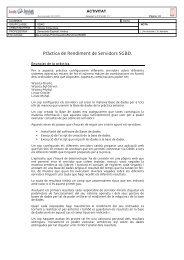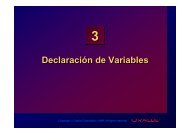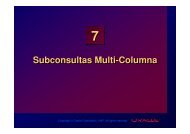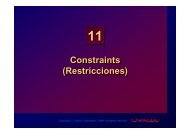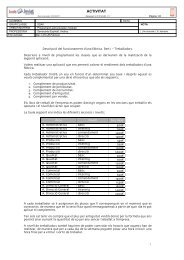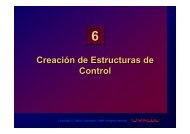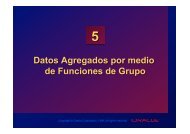Funciones a Nivel de Fila
Funciones a Nivel de Fila
Funciones a Nivel de Fila
Create successful ePaper yourself
Turn your PDF publications into a flip-book with our unique Google optimized e-Paper software.
3<br />
<strong>Funciones</strong> a <strong>Nivel</strong> <strong>de</strong> <strong>Fila</strong><br />
Copyright © Oracle Corporation, 1998. All rights reserved.
Objetivos<br />
Al completar esta lección, <strong>de</strong>bería ser<br />
capaz <strong>de</strong> hacer lo siguiente:<br />
• Explicar los diversos tipos <strong>de</strong><br />
funciones disponibles en SQL.<br />
• Incluir una variedad <strong>de</strong> funciones <strong>de</strong><br />
caracteres, numéricas y <strong>de</strong> datos en<br />
sentencias SELECT.<br />
• Explicar las funciones <strong>de</strong> conversión y<br />
la manera en que podrían ser usadas.<br />
3-2 Copyright © Oracle Corporation, 1998. All rights reserved.
<strong>Funciones</strong> SQL<br />
Entrada<br />
Función<br />
Salida<br />
arg 1<br />
arg 2<br />
arg n<br />
Las <strong>Funciones</strong><br />
Realizan<br />
Acciones<br />
Valor<br />
Resultado<br />
3-3 Copyright © Oracle Corporation, 1998. All rights reserved.
Dos Tipos <strong>de</strong> <strong>Funciones</strong> SQL<br />
<strong>Funciones</strong><br />
<strong>Funciones</strong> a<br />
<strong>Nivel</strong> <strong>de</strong> <strong>Fila</strong><br />
<strong>Funciones</strong> a<br />
<strong>Nivel</strong> <strong>de</strong><br />
Múltiples <strong>Fila</strong>s<br />
3-4 Copyright © Oracle Corporation, 1998. All rights reserved.
<strong>Funciones</strong> a <strong>Nivel</strong> <strong>de</strong> <strong>Fila</strong>: Sintaxis<br />
• Manipulan ítems <strong>de</strong> datos.<br />
• Aceptan argumentos y <strong>de</strong>vuelven un valor.<br />
• Actúan sobre cada fila retornada.<br />
• Devuelven un resultado por fila.<br />
• Modifican el tipo <strong>de</strong> datos.<br />
• Pue<strong>de</strong>n estar anidadas.<br />
Sintaxis:<br />
function_name (column|expression, [arg1, arg2,...])<br />
3-5 Copyright © Oracle Corporation, 1998. All rights reserved.
<strong>Funciones</strong> a <strong>Nivel</strong> <strong>de</strong> <strong>Fila</strong><br />
Character<br />
General<br />
Single-row<br />
functions<br />
Number<br />
Conversion<br />
Date<br />
3-6 Copyright © Oracle Corporation, 1998. All rights reserved.
<strong>Funciones</strong> <strong>de</strong> Caracteres<br />
<strong>Funciones</strong> <strong>de</strong><br />
Caracteres<br />
<strong>Funciones</strong> <strong>de</strong> Conversión<br />
LOWER<br />
UPPER<br />
INITCAP<br />
<strong>Funciones</strong> <strong>de</strong><br />
Manipulación <strong>de</strong> Caracteres<br />
CONCAT<br />
SUBSTR<br />
LENGTH<br />
INSTR<br />
LPAD<br />
3-7 Copyright © Oracle Corporation, 1998. All rights reserved.
<strong>Funciones</strong> <strong>de</strong> Conversión<br />
Conversión <strong>de</strong> ca<strong>de</strong>nas <strong>de</strong> caracteres<br />
Función<br />
LOWER('Curso SQL')<br />
UPPER ('Curso SQL')<br />
INITCAP('Curso SQL')<br />
Resultado<br />
curso sql<br />
CURSO SQL<br />
Curso Sql<br />
3-8 Copyright © Oracle Corporation, 1998. All rights reserved.
Uso <strong>de</strong> <strong>Funciones</strong> <strong>de</strong> Conversión<br />
Visualizar el número <strong>de</strong> empleado,<br />
nombre y nº <strong>de</strong> <strong>de</strong>partamento <strong>de</strong> “Blake”.<br />
SQL> SELECT empno, ename, <strong>de</strong>ptno<br />
2 FROM emp<br />
3 WHERE ename = 'blake';<br />
no rows selected<br />
SQL> SELECT empno, ename, <strong>de</strong>ptno<br />
2 FROM emp<br />
3 WHERE LOWER(ename) = 'blake';<br />
EMPNO ENAME<br />
DEPTNO<br />
--------- ---------- ---------<br />
7698 BLAKE 30<br />
3-9 Copyright © Oracle Corporation, 1998. All rights reserved.
<strong>Funciones</strong> <strong>de</strong> Manipulación <strong>de</strong><br />
Caracteres<br />
Manipulación <strong>de</strong> ca<strong>de</strong>nas <strong>de</strong> caracteres<br />
Función<br />
CONCAT('Good', 'String')<br />
SUBSTR('String',1,3)<br />
LENGTH('String')<br />
INSTR('String', 'r')<br />
LPAD(sal,10,'*')<br />
Resultado<br />
GoodString<br />
Str<br />
6<br />
3<br />
******5000<br />
3-10 Copyright © Oracle Corporation, 1998. All rights reserved.
Uso <strong>de</strong> <strong>Funciones</strong> <strong>de</strong> Manipulación <strong>de</strong><br />
Caracteres<br />
SQL> SELECT ename, CONCAT (ename, job), LENGTH(ename),<br />
2 INSTR(ename, 'A')<br />
3 FROM emp<br />
4 WHERE SUBSTR(job,1,5) = 'SALES';<br />
ENAME CONCAT(ENAME,JOB) LENGTH(ENAME) INSTR(ENAME,'A')<br />
---------- ------------------- ------------- ----------------<br />
MARTIN MARTINSALESMAN 6 2<br />
ALLEN ALLENSALESMAN 5 1<br />
TURNER TURNERSALESMAN 6 0<br />
WARD WARDSALESMAN 4 2<br />
3-11 Copyright © Oracle Corporation, 1998. All rights reserved.
• ROUND:<br />
<strong>Funciones</strong> Numéricas<br />
Redon<strong>de</strong>a un valor al <strong>de</strong>cimal<br />
especificado<br />
ROUND(45.926, 2) 45.93<br />
• TRUNC:<br />
Trunca un valor en el <strong>de</strong>cimal<br />
especificado<br />
TRUNC(45.926, 2) 45.92<br />
• MOD:<br />
Devuelve el resto <strong>de</strong> la división<br />
MOD(1600, 300) 100<br />
3-12 Copyright © Oracle Corporation, 1998. All rights reserved.
Uso <strong>de</strong> la Función ROUND<br />
Visualizar el valor 45.923 redon<strong>de</strong>ado a<br />
centenas, 0, y 10 posiciones <strong>de</strong>cimales.<br />
SQL> SELECT ROUND(45.923,2), ROUND(45.923,0),<br />
2 ROUND(45.923,-1)<br />
3 FROM SYS.DUAL;<br />
ROUND(45.923,2) ROUND(45.923,0) ROUND(45.923,-1)<br />
--------------- -------------- -----------------<br />
45.92 46 50<br />
3-13 Copyright © Oracle Corporation, 1998. All rights reserved.
Uso <strong>de</strong> la Función TRUNC<br />
Visualizar el valor 45.923 con TRUNC a<br />
centenas, 0, y 10 posiciones <strong>de</strong>cimales.<br />
SQL> SELECT TRUNC(45.923,2), TRUNC(45.923),<br />
2 TRUNC(45.923,-1)<br />
3 FROM SYS.DUAL;<br />
TRUNC(45.923,2) TRUNC(45.923) TRUNC(45.923,-1)<br />
--------------- ------------- ---------------<br />
45.92 45 40<br />
3-14 Copyright © Oracle Corporation, 1998. All rights reserved.
Uso <strong>de</strong> la Función MOD<br />
Calcular el resto <strong>de</strong> dividir el salario entre<br />
la comisión <strong>de</strong> cada empleado, cuyo<br />
trabajo sea “VENDEDOR”.<br />
SQL> SELECT ename, sal, comm, MOD(sal, comm)<br />
2 FROM emp<br />
3 WHERE job = 'SALESMAN';<br />
ENAME SAL COMM MOD(SAL,COMM)<br />
---------- --------- --------- -------------<br />
MARTIN 1250 1400 1250<br />
ALLEN 1600 300 100<br />
TURNER 1500 0 1500<br />
WARD 1250 500 250<br />
3-15 Copyright © Oracle Corporation, 1998. All rights reserved.
Trabajando con Fechas<br />
• Oracle almacena fechas en un formato numérico<br />
interno.<br />
– Siglo, año, mes, día, horas, minutos,<br />
segundos.<br />
• El formato <strong>de</strong> fecha por <strong>de</strong>fecto es DD-MON-YY.<br />
• SYSDATE es una función que <strong>de</strong>vuelve fecha y<br />
hora.<br />
• DUAL es una tabla virtual <strong>de</strong> la Base <strong>de</strong> Datos,<br />
que pue<strong>de</strong> ser usada para inspeccionar<br />
SYSDATE.<br />
3-16 Copyright © Oracle Corporation, 1998. All rights reserved.
Operadores Aritméticos <strong>de</strong> Fechas<br />
• Sumar o restar un número a ó <strong>de</strong> una<br />
fecha da por resultado una fecha.<br />
• Restar dos fechas para encontrar la<br />
cantidad <strong>de</strong> días entre esas fechas.<br />
• Sumar horas a una fecha dividiendo la<br />
cantidad <strong>de</strong> horas por 24.<br />
3-17 Copyright © Oracle Corporation, 1998. All rights reserved.
Uso <strong>de</strong> Operadores Aritméticos en<br />
Fechas<br />
SQL> SELECT ename, (SYSDATE-hiredate)/7 WEEKS<br />
2 FROM emp<br />
3 WHERE <strong>de</strong>ptno = 10;<br />
ENAME<br />
WEEKS<br />
---------- ---------<br />
KING 830.93709<br />
CLARK 853.93709<br />
MILLER 821.36566<br />
3-18 Copyright © Oracle Corporation, 1998. All rights reserved.
<strong>Funciones</strong> <strong>de</strong> Fecha<br />
FUNCION<br />
MONTHS_BETWEEN<br />
ADD_MONTHS<br />
NEXT_DAY<br />
LAST_DAY<br />
ROUND<br />
TRUNC<br />
DESCRIPCION<br />
Número <strong>de</strong> meses entre dos<br />
fechas<br />
Agregar meses según<br />
calendario, a una fecha<br />
Próximo día <strong>de</strong> la fecha<br />
especificada<br />
Ultimo día <strong>de</strong>l mes<br />
Redon<strong>de</strong>a una fecha<br />
Trunca una fecha<br />
3-19 Copyright © Oracle Corporation, 1998. All rights reserved.
Uso <strong>de</strong> <strong>Funciones</strong> <strong>de</strong> Fecha<br />
• MONTHS_BETWEEN ('01-SEP-95','11-JAN-94')<br />
19.6774194<br />
• ADD_MONTHS ('11-JAN-94',6)<br />
'11-JUL-94'<br />
• NEXT_DAY ('01-SEP-95','FRIDAY')<br />
'08-SEP-95'<br />
• LAST_DAY('01-SEP-95')<br />
'30-SEP-95'<br />
3-20 Copyright © Oracle Corporation, 1998. All rights reserved.
Uso <strong>de</strong> <strong>Funciones</strong> <strong>de</strong> Fecha<br />
• ROUND('25-JUL-95','MONTH')<br />
01-AUG-95<br />
• ROUND('25-JUL-95','YEAR')<br />
01-JAN-96<br />
• TRUNC('25-JUL-95','MONTH')<br />
01-JUL-95<br />
• TRUNC('25-JUL-95','YEAR')<br />
01-JAN-95<br />
3-21 Copyright © Oracle Corporation, 1998. All rights reserved.
<strong>Funciones</strong> <strong>de</strong> Conversión<br />
Conversión <strong>de</strong><br />
Tipos <strong>de</strong> Datos<br />
Conversión<br />
Implícita<br />
Conversión<br />
Explícita<br />
3-22 Copyright © Oracle Corporation, 1998. All rights reserved.
Conversión Implícita <strong>de</strong>l Tipo <strong>de</strong> Dato<br />
Para asignaciones, Oracle automáticamente<br />
pue<strong>de</strong> convertir:<br />
De<br />
VARCHAR2 o CHAR<br />
VARCHAR2 o CHAR<br />
NUMBER<br />
DATE<br />
A<br />
NUMBER<br />
DATE<br />
VARCHAR2<br />
VARCHAR2<br />
3-23 Copyright © Oracle Corporation, 1998. All rights reserved.
Conversión Explícita <strong>de</strong>l Tipo <strong>de</strong> Dato<br />
Para evaluar una expresión, Oracle<br />
automáticamente pue<strong>de</strong> convertir:<br />
De<br />
A<br />
VARCHAR2 o CHAR<br />
VARCHAR2 o CHAR<br />
NUMBER<br />
DATE<br />
3-24 Copyright © Oracle Corporation, 1998. All rights reserved.
Conversión Explícita <strong>de</strong>l Tipo <strong>de</strong> Dato<br />
TO_NUMBER<br />
TO_DATE<br />
NUMBER<br />
CHARACTER<br />
DATE<br />
TO_CHAR<br />
TO_CHAR<br />
3-25 Copyright © Oracle Corporation, 1998. All rights reserved.
Función TO_CHAR con Fechas<br />
TO_CHAR(date, 'fmt')<br />
El formato:<br />
• Debe estar encerrado entre comillas simples y<br />
es sensible a mayúsculas/minúsculas.<br />
• Pue<strong>de</strong> incluir cualquier elemento <strong>de</strong> formato<br />
<strong>de</strong> fecha válido.<br />
• Tiene un elemento fm (fill mo<strong>de</strong>) para eliminar<br />
espacios en blanco <strong>de</strong> relleno o suprimir ceros<br />
a la izquierda.<br />
• Está separado <strong>de</strong> la fecha por una coma.<br />
3-26 Copyright © Oracle Corporation, 1998. All rights reserved.
Elementos <strong>de</strong>l Mo<strong>de</strong>lo Formato <strong>de</strong> Fecha<br />
YYYY<br />
YEAR<br />
MM<br />
MONTH<br />
DY<br />
DAY<br />
Año completo en número<br />
Año en letras<br />
Nº <strong>de</strong>l mes con dos dígitos<br />
Nombre completo <strong>de</strong>l mes<br />
Abreviatura <strong>de</strong> tres letras <strong>de</strong>l<br />
día <strong>de</strong> la semana<br />
Nombre completo <strong>de</strong>l día<br />
3-27 Copyright © Oracle Corporation, 1998. All rights reserved.
Elementos <strong>de</strong>l Formato <strong>de</strong> Fechas<br />
• Obtención <strong>de</strong> la hora:<br />
HH24:MI:SS AM<br />
15:45:32 PM<br />
• Añadir ca<strong>de</strong>nas <strong>de</strong> caracteres encerrándolas<br />
entre dobles comillas.<br />
DD "of" MONTH 12 of OCTOBER<br />
• Sufijo que permita obtener el nº <strong>de</strong>l día en letra.<br />
ddspth<br />
fourteenth<br />
3-28 Copyright © Oracle Corporation, 1998. All rights reserved.
Formato <strong>de</strong> Fecha RR<br />
Año Actual<br />
1995<br />
1995<br />
2001<br />
2001<br />
Fecha Específicada<br />
27-OCT-95<br />
27-OCT-17<br />
27-OCT-17<br />
27-OCT-95<br />
Formato RR<br />
1995<br />
2017<br />
2017<br />
1995<br />
FormatoYY<br />
1995<br />
1917<br />
2017<br />
2095<br />
Si los 2<br />
dígitos <strong>de</strong>l<br />
año<br />
corriente<br />
están<br />
0-49<br />
50-99<br />
Si los 2 dígitos especificados <strong>de</strong>l año están<br />
0-49 50-99<br />
La fecha <strong>de</strong>vuelta<br />
correspon<strong>de</strong> al<br />
siglo corriente.<br />
La fecha <strong>de</strong>vuelta<br />
correspon<strong>de</strong> al<br />
siglo posterior al<br />
corriente.<br />
La fecha <strong>de</strong>vuelta<br />
correspon<strong>de</strong> al siglo<br />
anterior al corriente.<br />
La fecha <strong>de</strong>vuelta<br />
correspon<strong>de</strong> al siglo<br />
corriente.<br />
3-29 Copyright © Oracle Corporation, 1998. All rights reserved.
Función TO_CHAR con Fechas<br />
SQL> SELECT ename,<br />
2 TO CHAR(hiredate, 'fmDD Month YYYY') HIREDATE<br />
3 FROM emp;<br />
ENAME HIREDATE<br />
---------- -----------------<br />
KING 17 November 1981<br />
BLAKE 1 May 1981<br />
CLARK 9 June 1981<br />
JONES 2 April 1981<br />
MARTIN 28 September 1981<br />
ALLEN 20 February 1981<br />
...<br />
14 rows selected.<br />
3-30 Copyright © Oracle Corporation, 1998. All rights reserved.
Función TO_CHAR con Números<br />
TO_CHAR(number, 'fmt')<br />
Use estos formatos con la función<br />
TO_CHAR para mostrar un carácter como<br />
un número.<br />
9<br />
0<br />
$<br />
L<br />
.<br />
,<br />
Representa un número<br />
Fuerza a que se muestre el 0 (cero)<br />
Signo <strong>de</strong>l dólar<br />
Usa el símbolo <strong>de</strong> moneda local<br />
Imprime el punto <strong>de</strong>cimal<br />
Imprime el indicador <strong>de</strong> millar<br />
3-31 Copyright © Oracle Corporation, 1998. All rights reserved.
Uso <strong>de</strong> la<br />
Función TO_CHAR con Números<br />
SQL> SELECT TO_CHAR(sal,'$99,999') SALARY<br />
2 FROM emp<br />
3 WHERE ename = 'SCOTT';<br />
SALARY<br />
--------<br />
$3,000<br />
3-32 Copyright © Oracle Corporation, 1998. All rights reserved.
<strong>Funciones</strong><br />
TO_NUMBER y TO_DATE<br />
• Convierte una ca<strong>de</strong>na <strong>de</strong> caracteres a<br />
un formato numérico usando la función<br />
TO_NUMBER<br />
TO_NUMBER(char)<br />
• Convierte una ca<strong>de</strong>na <strong>de</strong> caracteres a<br />
un formato <strong>de</strong> fecha usando la función<br />
TO_DATE<br />
TO_DATE(char[, 'fmt'])<br />
3-33 Copyright © Oracle Corporation, 1998. All rights reserved.
NVL Function<br />
Convierte un nulo a un valor.<br />
• Los tipos <strong>de</strong> datos pue<strong>de</strong>n ser <strong>de</strong> fecha,<br />
ca<strong>de</strong>nas <strong>de</strong> caracteres y números.<br />
• Los tipos <strong>de</strong> datos <strong>de</strong>ben coincidir:<br />
– NVL(comm,0)<br />
– NVL(hiredate,'01-JAN-97')<br />
– NVL(job,'No Job Yet')<br />
3-34 Copyright © Oracle Corporation, 1998. All rights reserved.
Uso <strong>de</strong> la Función NVL<br />
SQL> SELECT ename, sal, comm, (sal*12)+NVL(comm,0)<br />
2 FROM emp;<br />
ENAME SAL COMM (SAL*12)+NVL(COMM,0)<br />
---------- --------- --------- --------------------<br />
KING 5000 60000<br />
BLAKE 2850 34200<br />
CLARK 2450 29400<br />
JONES 2975 35700<br />
MARTIN 1250 1400 16400<br />
ALLEN 1600 300 19500<br />
...<br />
14 rows selected.<br />
3-35 Copyright © Oracle Corporation, 1998. All rights reserved.
La Función DECODE<br />
Hace las veces <strong>de</strong> sentecias CASE o<br />
IF-THEN-ELSE, para facilitar consultas<br />
condicionales.<br />
DECODE(col/expression, search1, result1<br />
[, search2, result2,...,]<br />
[, <strong>de</strong>fault])<br />
3-36 Copyright © Oracle Corporation, 1998. All rights reserved.
Uso <strong>de</strong> la Función DECODE<br />
SQL> SELECT job, sal,<br />
2 DECODE(job, 'ANALYST' SAL*1.1,<br />
3 'CLERK', SAL*1.15,<br />
4 'MANAGER', SAL*1.20,<br />
5 SAL)<br />
6 REVISED_SALARY<br />
7 FROM emp;<br />
JOB<br />
SAL REVISED_SALARY<br />
--------- --------- --------------<br />
PRESIDENT 5000 5000<br />
MANAGER 2850 3420<br />
MANAGER 2450 2940<br />
...<br />
14 rows selected.<br />
3-37 Copyright © Oracle Corporation, 1998. All rights reserved.
Anudamiento <strong>de</strong> <strong>Funciones</strong><br />
• Las funciones a nivel <strong>de</strong> fila pue<strong>de</strong>n ser<br />
anidadas hasta cualquier nivel.<br />
• Las funciones anidadas son evaluadas <strong>de</strong>s<strong>de</strong><br />
el nivel más profundo al nivel menos<br />
profundo.<br />
F3(F2(F1(col,arg1),arg2),arg3)<br />
Paso 1 = Resultado 1!<br />
Paso 2 = Resultado 2!<br />
Paso 3 = Resultado 3!<br />
3-38 Copyright © Oracle Corporation, 1998. All rights reserved.
<strong>Funciones</strong> Anidadas<br />
SQL> SELECT ename,<br />
2 NVL(TO_CHAR(mgr),'No Manager')<br />
3 FROM emp<br />
4 WHERE mgr IS NULL;<br />
ENAME NVL(TO_CHAR(MGR),'NOMANAGER')<br />
---------- -----------------------------<br />
KING No Manager<br />
3-39 Copyright © Oracle Corporation, 1998. All rights reserved.
Resumen<br />
Use funciones para:<br />
• Realizar cáculos sobre los datos<br />
• Modificar datos <strong>de</strong> forma individual<br />
• Manipular la salida <strong>de</strong> grupos <strong>de</strong><br />
registros<br />
• Alterar formatos <strong>de</strong> fecha en su<br />
visualización<br />
• Convertir tipos <strong>de</strong> datos <strong>de</strong> columnas<br />
3-40 Copyright © Oracle Corporation, 1998. All rights reserved.
Visión General <strong>de</strong> la Práctica<br />
• Crear consultas que requieran el uso <strong>de</strong><br />
funciones numéricas, <strong>de</strong> caracteres y <strong>de</strong><br />
fechas.<br />
• Usar concatenación con funciones.<br />
• Escribir consultas case insensitive para probar<br />
la utilidad <strong>de</strong> las funciones <strong>de</strong> caracteres.<br />
• Ejecutar cálculos sobre años y meses <strong>de</strong><br />
servicio para un empleado.<br />
• Determinar la fecha <strong>de</strong> revisión para un<br />
empleado.<br />
3-41 Copyright © Oracle Corporation, 1998. All rights reserved.



